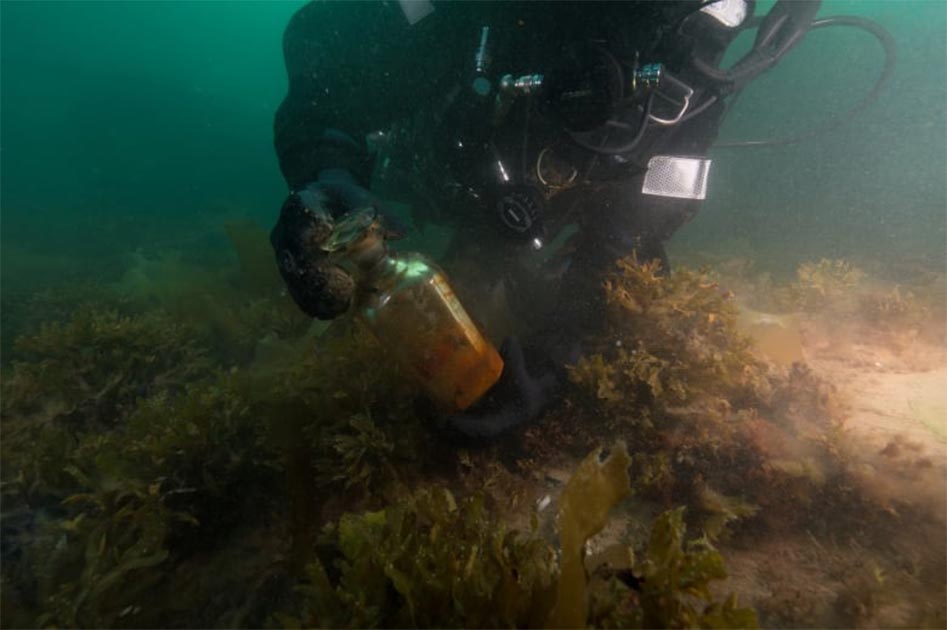Underwater Archaeologists Dive Into Doomed Arctic Ships
In 1845, HMS Erebus and her companion ship, the HMS Terror, set sail from Greenhite in England with the mission of crossing the Atlantic Ocean to the Pacific Ocean through the Arctic. But this ill-fated voyage resulted in both ships becoming trapped in sea ice, forcing their crews into a horrific situation: wandering in a snow and ice field searching for help, that just wasn’t there.
The 128 crew members sent their final group message on April 25, 1848, in which they indicated that the survivors were abandoning their ships and they were all subsequently lost to history, dying under what were unknown circumstances, until now.
The End of a Tragic Affair
Now, a new collection of artifacts pulled from the wreckage of HMS Erebus have been presented by researchers from Parks Canada, including: a captain's mustard, a lieutenant's epaulet, and an accordion. According to a report in Daily Mail, the Parks Canada underwater archaeology team made “93 dives over a three-week period in August and September of 2019” and spent a total of “110 hours” exploring the wreckage and deriving new clues about what life on the doomed ship might have been like.

Epaulets from an officer’s uniform pulled from the HMS Erebus wreckage. (Parks Canada)
It is known the two ships had enough provisions for a seven year journey and that they had made it as far as King William Island in Canada, where they became trapped in thick sea ice. It is unclear to archaeologists just how long the ships’ respective crews would have set out foot patrols in search of help, but trying to answer such questions, Parks Canada’s Marc-André Bernier told CBC News that the team of underwater archaeologists aimed to find out what happened to the final survivors of the expedition. The researchers were tackling tough questions such as, “did discipline break down or was it maintained until the end?”
- Preserved in Legends and Ice: What Led to the Extinction of the Dorset Culture?
- Neolithic Chic: Body Piercing Fashion from the Arctic Around 5,000 Years Ago
- Magic Mountains and Sea Serpents: the Secrets of Early Arctic Maps
Class Divisions at Sea
The HMS Erebus and the HMS Terror set sail from just outside London in 1845 planning to chart a path to the Pacific Ocean over the Arctic Circle, where they became trapped in ice. Erebus’ wreck was only discovered in 2014 and the Terror was found in 2016. Bernier said the archaeological work conducted on Terror enabled the researchers to look inside the cabins and that they are now finding the artifacts of specific individuals, which he says indicate “class divisions” among the crew.
An example of these divisions of class was found in the ship’s galley, where a “special bottle of prepared mustard” had been intended for use at the captain’s table, along with a silver spoon and sugar cube tongs. Furthermore, in one cabin a set of epaulets were discovered for a lieutenant ’s uniform with fine ceramic dishes and a hairbrush holding human hairs.

The arctic archaeologists found a hairbrush that is still holding human hairs. (Parks Canada)
A writing quill and a pencil were also discovered, but unfortunately they haven’t found any written diaries that may have illustrated what happened to the crew in the last days of the tragedy.
On the other side of the tracks, the divers found evidence that the crew had very little room for personal effects and that two people shared one small chest, which they used as benches in the mess hall to save space.

Underwater archaeologists found a pencil case in the HMS Erebus wreck. (Parks Canada)
The Pros and Cons of Work as an Underwater Archaeologist in the Arctic
In an ABC News report Bernier said the cold and still arctic conditions helped preserved the wrecks, allowing divers access to places that have not been displaced or moved since the ships sunk, but conversely, the extremely cold temperatures, strong currents, and unpredictable weather make the conditions exceptionally dangerous for the underwater archaeologists with potential to “freeze regulators, cause LCD monitors to cut off, and speed up the rate at which batteries go dead.”
- Did This Ancient Explorer Make It to The Arctic In 325 BC?
- Astonishing Human Heads: Do Satellite Photographs Now Prove Existence of Humans on Antarctica…6000 Years Ago? – Part I
- Inuit folklore kept alive story of missing Franklin expedition to north-west passage
So far as the poor souls who perished on and near these two ships are concerned: when divers discovered the wreckages of the two ships they were located curiously far apart from one another, and so far as records show nobody was ever heard from again. And going by the skeletons and personal artifacts found at the site so far, according to the Parks Canada spokesman, “no-one made it even a fifth of the way to safety.”

Location of the wrecks of HMS Erebus and HMS Terror. (CBC News/Parks Canada)
Top Image: A Parks Canada underwater archeologist works about eight meters (26.25 ft.) below the surface of the water. Source: Underwater archeology team/Parks Canada
By Ashley Cowie



















